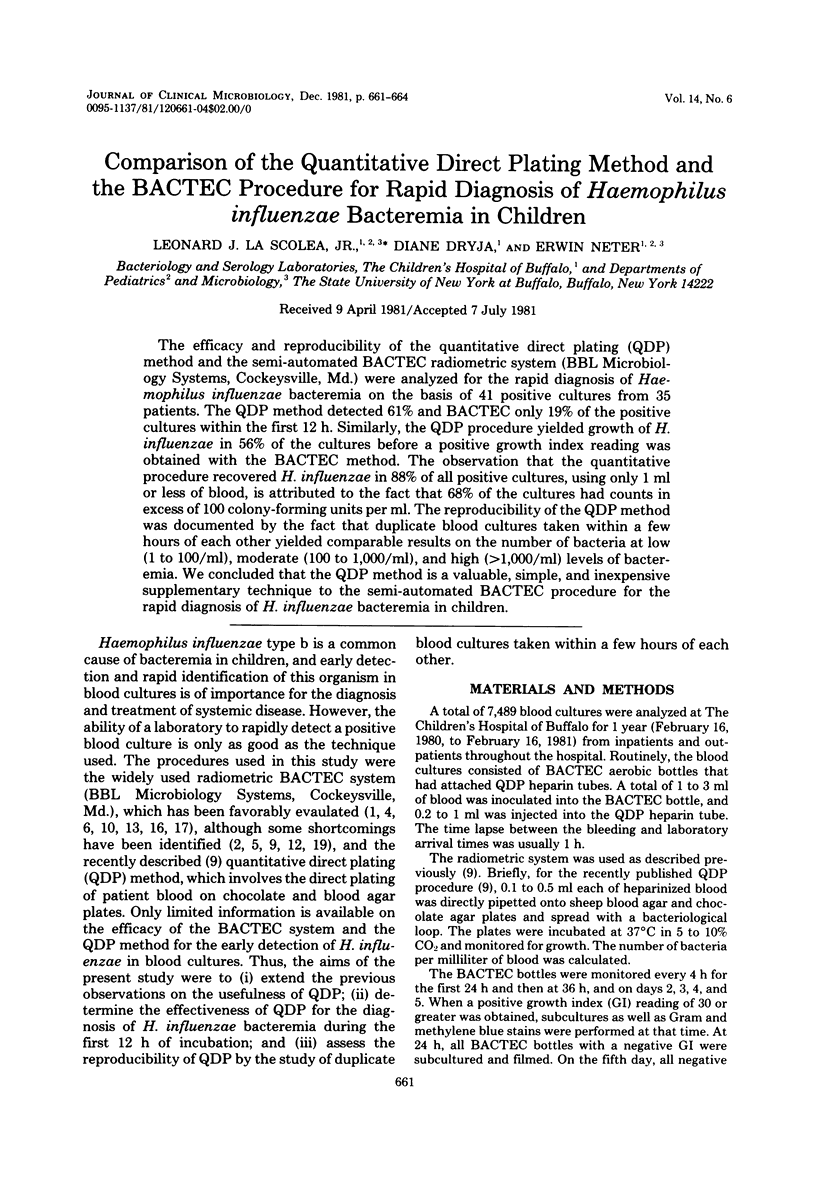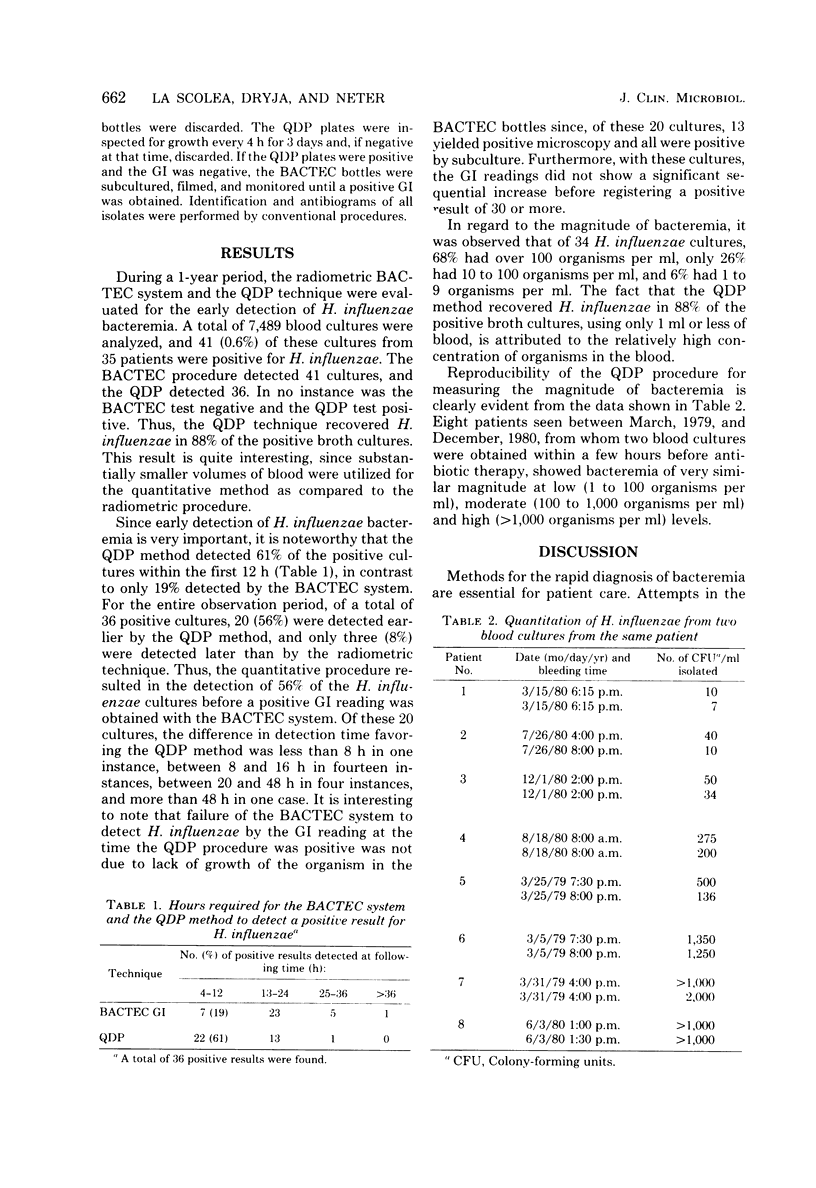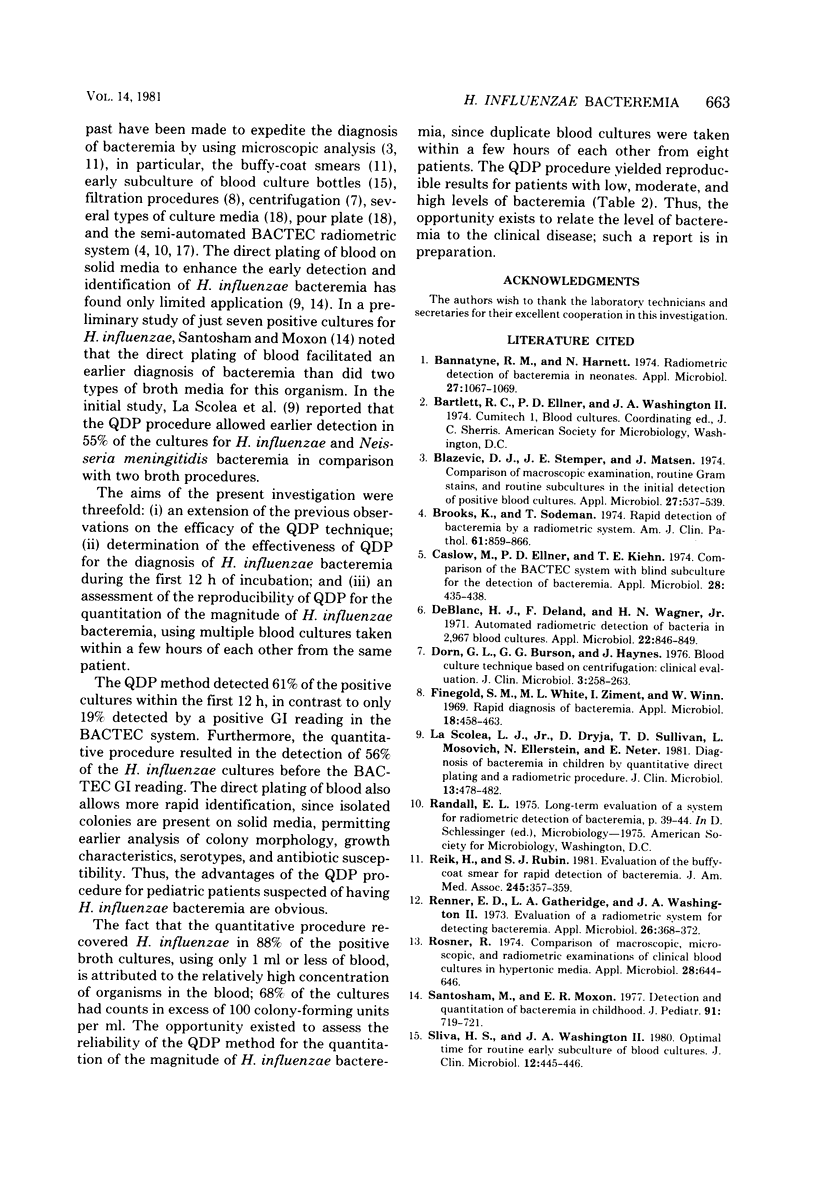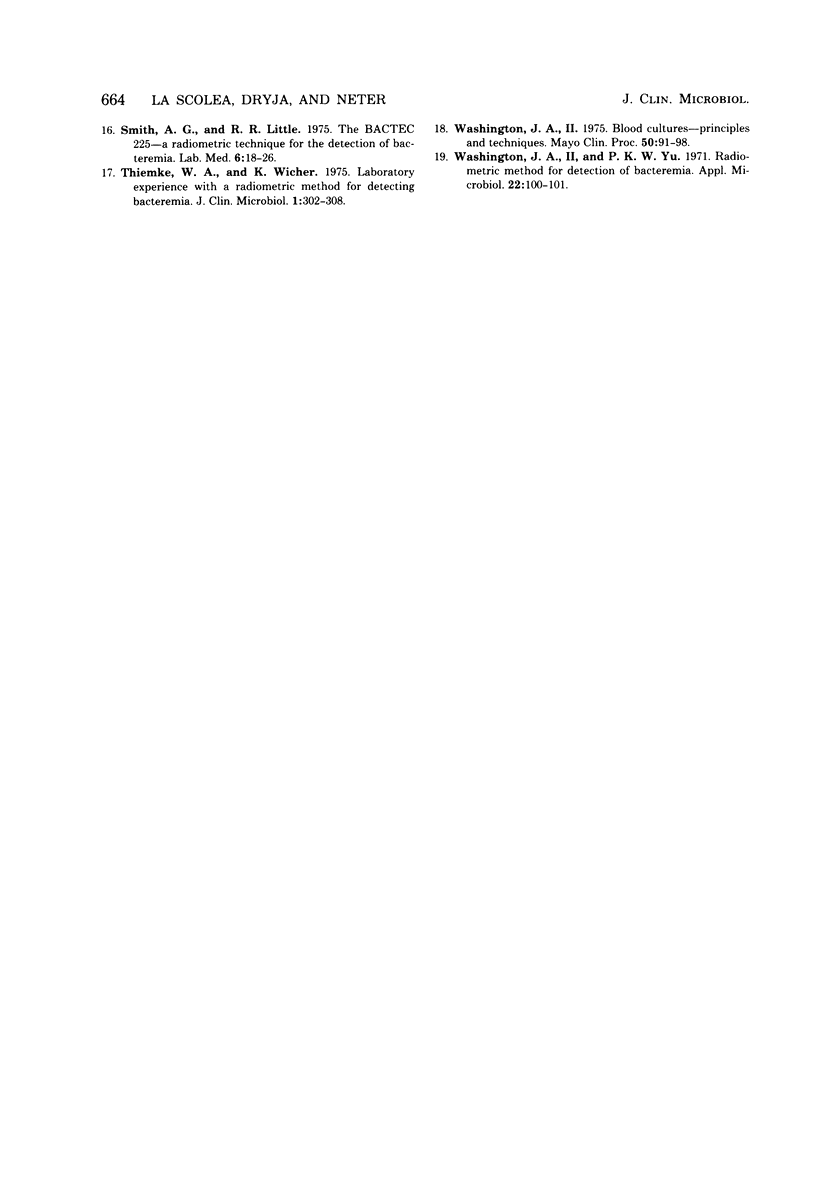Abstract
The efficacy and reproducibility of the quantitative direct plating (QDP) method and the semi-automated BACTEC radiometric system (BBL Microbiology Systems, Cockeysville, Md.) were analyzed for the rapid diagnosis of Haemophilus influenzae bacteremia on the basis of 41 positive cultures from 35 patients. The QDP method detected 61% and BACTEC only 19% of the positive cultures within the first 12 h. Similarly, the QDP procedure yielded growth of H. influenzae in 56% of the cultures before a positive growth index reading was obtained with the BACTEC method. The observation that the quantitative procedure recovered H. influenzae in 88% of all positive cultures, using only 1 ml or less of blood, is attributed to the fact that 68% of the cultures had counts in excess of 100 colony-forming units per ml. The reproducibility of the QDP method was documented by the fact that duplicate blood cultures taken within a few hours of each other yielded comparable results on the number of bacteria at low (1 to 100/ml), moderate (100 to 1,000/ml), and high (greater than 1,000/ml) levels of bacteremia. We concluded that the QDP method is a valuable, simple, and inexpensive supplementary technique to the semi-automated BACTEC procedure for the rapid diagnosis of H.influenzae bacteremia in children.
Full text
PDF



Selected References
These references are in PubMed. This may not be the complete list of references from this article.
- Bannatyne R. M., Harnett N. Radiometric detection of bacteremia in neonates. Appl Microbiol. 1974 Jun;27(6):1067–1069. doi: 10.1128/am.27.6.1067-1069.1974. [DOI] [PMC free article] [PubMed] [Google Scholar]
- Blazevic D. J., Stemper J. E., Matsen J. M. Comparison of macroscopic examination, routine gram stains, and routine subcultures in the initial detection of positive blood cultures. Appl Microbiol. 1974 Mar;27(3):537–539. doi: 10.1128/am.27.3.537-539.1974. [DOI] [PMC free article] [PubMed] [Google Scholar]
- Brooks K., Sodeman T. Rapid detection of bacteremia by a radiometric system. A clinical evaluation. Am J Clin Pathol. 1974 Jun;61(6):859–866. doi: 10.1093/ajcp/61.6.859. [DOI] [PubMed] [Google Scholar]
- Caslow M., Ellner P. D., Kiehn T. E. Comparison of the BACTEC system with blind subculture for the detection of bacteremia. Appl Microbiol. 1974 Sep;28(3):435–438. doi: 10.1128/am.28.3.435-438.1974. [DOI] [PMC free article] [PubMed] [Google Scholar]
- DeBlanc H. J., Jr, DeLand F., Wagner H. N., Jr Automated radiometric detection of bacteria in 2,967 blood cultures. Appl Microbiol. 1971 Nov;22(5):846–849. doi: 10.1128/am.22.5.846-849.1971. [DOI] [PMC free article] [PubMed] [Google Scholar]
- Dorn G. L., Burson G. G., Haynes J. R. Blood culture technique based on centrifugation: clinical evaluation. J Clin Microbiol. 1976 Mar;3(3):258–263. doi: 10.1128/jcm.3.3.258-263.1976. [DOI] [PMC free article] [PubMed] [Google Scholar]
- Finegold S. M., White M. L., Ziment I., Winn W. R. Rapid diagnosis of bacteremia. Appl Microbiol. 1969 Sep;18(3):458–463. doi: 10.1128/am.18.3.458-463.1969. [DOI] [PMC free article] [PubMed] [Google Scholar]
- La Scolea L. J., Jr, Dryja D., Sullivan T. D., Mosovich L., Ellerstein N., Neter E. Diagnosis of bacteremia in children by quantitative direct plating and a radiometric procedure. J Clin Microbiol. 1981 Mar;13(3):478–482. doi: 10.1128/jcm.13.3.478-482.1981. [DOI] [PMC free article] [PubMed] [Google Scholar]
- Reik H., Rubin S. J. Evaluation of the buffy-coat smear for rapid detection of bacteremia. JAMA. 1981 Jan 23;245(4):357–359. [PubMed] [Google Scholar]
- Renner E. D., Gatheridge L. A., Washington J. A., 2nd Evaluation of radiometric system for detecting bacteremia. Appl Microbiol. 1973 Sep;26(3):368–372. doi: 10.1128/am.26.3.368-372.1973. [DOI] [PMC free article] [PubMed] [Google Scholar]
- Rosner R. Comparison of macroscopic, microscopic, and radiometric examinations of clinical blood cultures in hypertonic media. Appl Microbiol. 1974 Oct;28(4):644–646. doi: 10.1128/am.28.4.644-646.1974. [DOI] [PMC free article] [PubMed] [Google Scholar]
- Santosham M., Moxon E. R. Detection and quantitation of bacteremia in childhood. J Pediatr. 1977 Nov;91(5):719–721. doi: 10.1016/s0022-3476(77)81022-6. [DOI] [PubMed] [Google Scholar]
- Sliva H. S., Washington J. A., 2nd Optimal time for routine early subculture of blood cultures. J Clin Microbiol. 1980 Sep;12(3):445–446. doi: 10.1128/jcm.12.3.445-446.1980. [DOI] [PMC free article] [PubMed] [Google Scholar]
- Thiemke W. A., Wicher K. Laboratory experience with a radiometric method for detecting bacteremia. J Clin Microbiol. 1975 Mar;1(3):302–308. doi: 10.1128/jcm.1.3.302-308.1975. [DOI] [PMC free article] [PubMed] [Google Scholar]
- Washington J. A., 2nd Blood cultures: principles and techniques. Mayo Clin Proc. 1975 Feb;50(2):91–98. [PubMed] [Google Scholar]
- Washington J. A., 2nd, Yu P. K. Radiometric method for detection of bacteremia. Appl Microbiol. 1971 Jul;22(1):100–101. doi: 10.1128/am.22.1.100-101.1971. [DOI] [PMC free article] [PubMed] [Google Scholar]


